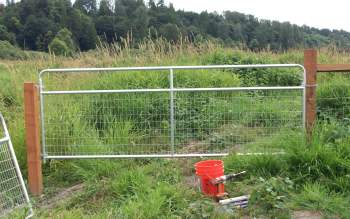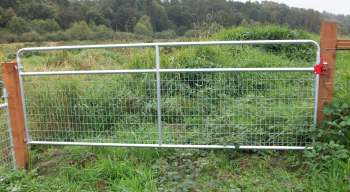Here are a few more pictures of my recent gate-hanging lessons. The gates I buy are labled for the gate opening size, if you plan to have the gate fit that opening exactly. But the gate frames are actually about 4″ narrower; this allows room for the hinges on one side, and a little bit of clearance on the other so that the gate can swing freely in both directions. For most of my big gates, I had planned on using interior latches, which require a very specific amount of extra space allowed for them– I think between 2-2 3/4″, or something like that.
I tried very hard to place the posts exactly right to get the opening within the tolerance allowed. But, I didn’t always succeed, so I had one opening that was a little too narrow. So, the gate only swings in one direction here, and has a latch that can accommodate one-hand operation. This latch also holds the weight of the gate up, to help minimize sagging (upper left photo). And, it accepts a padlock, which I may choose to use since this borders neighboring property.
This gate opening also had the problem of too much slope under the gate. It would have been wiser to have placed this gate further down the fenceline where the ground was level. But doing gates mid-fence instead of along the corners requires H-braces on either side, so costs a lot more in extra posts and work. So, I made do with this corner gate and back-filled some soil at the low point. It can now keep in livestock, but not the dogs (or coyotes)-they scoot underneath. I may need to do some more work with it in the future.
Here is what it looks like now. 
The opposite problem I had was with openings that ended up a little too wide. I just filled in the extra space with treated 2×6″ boards, as needed, so that there aren’t tempting openings for lambs and dogs to try to squeeze through.
Here is one opening that ended up too wide- the gate swings nicely in both directions, but there is a good 4″ of extra clearance I didn’t intend to have!
 And, below, is the solution: a “sandwich” of two 2×6’s. I’ve seen people correct even bigger gaps by building a box on the side of the post, so that the full width of a 2×6 can extent out and have another 2×6 capping on top of that, to provide a spot for the latch.
And, below, is the solution: a “sandwich” of two 2×6’s. I’ve seen people correct even bigger gaps by building a box on the side of the post, so that the full width of a 2×6 can extent out and have another 2×6 capping on top of that, to provide a spot for the latch.
This is another one-hand latch, this one lets the gate go in either direction, and also supports its weight, when closed, to ease sagging. And, this one also accepts a padlock. I’ve installed brass combination locks on the gates by the road, just to discourage any “visitors.” I’m less worried about theft than rowdy teenagers being tempted to do any 4×4’ing in the pasture, or do any “cow tipping.” But, with the combo locks, I can give the combo to anyone who needs to get in, like my friends who want to use the field to train their dogs for tracking. 
